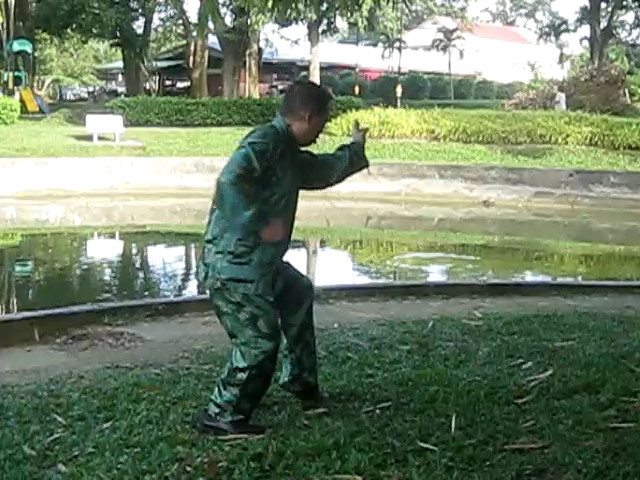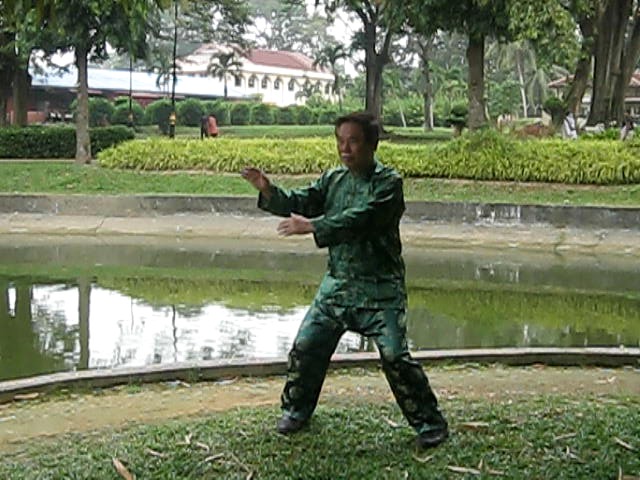RANKING OF SHORT KUNGFU SETS FOR VARIOUS BENEFITS

"Golden Dragon Plays with Water" in Dragon in Zen
Question
In our school, kung fu is also chi kung but with the added benefit of combat efficiency. My personal favorite short kungfu set for solo daily practice nowadays is from Wuzuquan, ie San Zhan alternating with Ti Jiao (which is quite similar to San Zhan but with kick techniques added).
For our busy modern scholar-warriors, time for daily extended practice is limited but due to the practice efficacy in our school, the latest typical recommendation for daily practice duration is about 15 minutes for chi kung or 30 minutes for kung fu: but over the years, on a personal note, I still have been able to enjoy adequate benefits despite reducing daily practice time to 2-3 or 5 minutes for chi kung and kungfu respectively!
The latter situation is possible by choosing shorter kungfu sets which takes about 1 minute only to perform, eg a specialized Shaolin kungfu set like San Zhan or Ti Jiao, a basic Shaolin kungfu set like Lohan Asks the Way, a simplified Taijiquan set like Cloud Hands or a spiritual cultivation set like Dragon in Zen; although all these sets have strikes, qinna and dim mak, some sets have no formal felling or kick techniques, followed by chi flow and standing meditation.
If all things were equal, for a time-constrained non-beginner kungfu practitioner in our school aiming for health, combat efficiency (technique, skill, internal force) and mind training, how does the various abovementioned short kungfu sets compare in terms of efficacy?
Dr. Damian Kissey
Answer
Thank you, Damian, for the very beneficial and interesting information concerning how to practice when one has little time. I would like to elaborate on this beneficial and interesting information for the sake of our Family members, both advanced and at the beginning level.
We have many short kungfu sets in our school that give us many benefits and save much time in practice. Of course, this does not mean that the longer kungfu sets are not beneficial. These longer sets are useful for other purposes.
Some of the short kungfu sets are those that you have mentioned, like San Zhan, Ti Jiao, Lohan Asks the Way, Cloud Hands, and Dragon in Zen. Other short sets include Four Gates, 36-Pattern Tiger-Crane Set, Twenty Punches, Lohan Tames Tiger, Old Eagle Catches Snake, Eighteen Collection, Five Elemental Fist, Shaolin 36 Leg Technique Set, and Little Lohan Fist,
Because our training emphasizes on developing skills, we can use these short sets to develop internal force, which in turn gives us good health, vitality, longevity, mental clarity, spiritual joys, peak performance and combat efficiency. Practitioners in most other schools, despite having practiced for many years, may not be able to do so.
All these short sets can be used to counter, not just defend against, any form of attack – if the exponent knows how. In other words, if the exponent knows the secrets, he can use any one of the short sets to counter any strike, any kick, any felling attack, and any qinna attack. If he does not know the secrets, he may think, wrongly, that the set can only be used against strikes. If he only performs the set for demonstration, and never practice combat application, he does not even know how to use the set against strikes.
San Zhan is an excellent example. When I first learned San Zhan more than 40 years ago in the early 1970s, when I was already called a kungfu genius, I did not know its sophisticated combat application, except its simple blocks and strikes. When I taught San Zhan 40 years later in 2012, I realized that it could be excellently used against any attack!
You, Damian, is an excellent living example. I remember that before a special course in 2011, you asked me how to apply San Zhan to counter felling attacks and sophisticated qinna techniques. I chose not to show you, but during the course itself you demonstrated the counters very well.
Some of these short sets are complete by themselves in the four categories of attack, i.e. they include striking, kicking, felling and qinna. Yet, with some modifications gained from the knowledge and experience in our training, we can use techniques from these short sets to execute categories of attack that are not obviously shown. For example, felling techniques are not obviously shown in San Zhan, but we can modify some San Zhan techniques to fell opponents.
Nevertheless, these modifications are for ad hoc purpose, i.e. if the appropriate combat situations arise. If we wish to apply a special category of attack, like a special kicking or qinna technique, it is better to choose it from a special set, like a 38 Leg Technique Set or a 72 Qinna Technique Set.
San Zhan is a good example differentiating the initiated from the uninitiated. Except for kicks, for which I had to compose Ti Jiao for the Special Wuzuquan Course in 2012, San Zhan includes all the other categories of attack, and can be used to counter any category of attack, including kicks. To the uninitiated of the profundity in simplicity of San Zhan combat application, they only know that San Zhan techniques can be used for striking and for defending against striking. For the totally uninitiated in combat application, they do not even know that San Zhan techniques can be used in the category of striking.
If all other things were equal, for a non-beginner kungfu practitioner in our school, the rankings of efficiency of the above-mentioned sets in terms of certain qualities are as follows.
For health, combat efficiency (including techniques, skills, internal force), and mind training, the ranking is as follows:
San Zhan, Ti Jiao, Lohan Asks the Way, Cloud Hands, and Dragon in Zen.
For health, the ranking is as follows:
Cloud Hands, San Zhan, Dragon in Zen, Ti Jiao, and Lohan Asks the Way.
For combat efficiency the ranking is as follows:
San Zhan, Dragon in Zen, Cloud Hands, Ti Jiao, Lohan Asks the Way.
If we break down combat efficiency into individual qualities of techniques, skills and internal force, the lists are as follows.
For techniques, the ranking is as follows:
Dragon in Zen, San Zhan, Cloud Hands, Lohan Asks the Way, and Ti Jiao.
For skills, the ranking is as follows:
San Zhan, Cloud Hands, Dragon in Zen, Lohan Asks the Way, and Ti Jiao.
For internal force, the ranking is as follows:
San Zhan, Lohan Asks the Way, Cloud Hands, Ti Jiao, and Dragon in Zen.
For mind training, the ranking is as follows:
Dragon in Zen, San Zhan, Cloud Hands, Ti Jiao, and Lohan Asks the Way.
You have not asked these two questions, but the rankings concern the great majority of kungfu practitioners who perform kungfu for demonstration (not necessarily public) and who use free fighting which resembles kick boxing in combat.
For demonstration, the ranking is as follows:
Dragon in Zen, Lohan Asks the Way, Cloud Hands, Ti Jiao, and San Zhan.
For using free fighting that resembles kick boxing, the ranking is as follows:
Ti Jiao, Lohan Asks the Way, Dragon in Zen, Cloud Hands, and San Zhan.
The following three points should be noted. The rankings shown here are arbitrary. Other people may rank their preference differently.
When a particular set is placed last in the ranking for a particular quality, it means that, in my opinion, other sets are relatively more beneficial in this quality. It does not mean that this set is not beneficial at all. For example, in the quality for health, Lohan Asks the Way is placed fifth. This means that the other four sets are more beneficial in their contribution to health. By itself, Lohan Askes the Way is also very beneficial to health for our Family members.
These rankings apply to our school where our Family members can use the sets to generate an energy flow, develop internal force, understand combat application, and train the mind. Other people who do hot have any or all these abilities will rank the sets differently.

"Cloud Hands" in Taijiquan Cloud Hands
This question and answer are reproduced from the thread Wu Zu Quan -- 10 Questions to Grandmasrter Wong in the Shaolin Wahnam Discussion Forum.
LINKS
